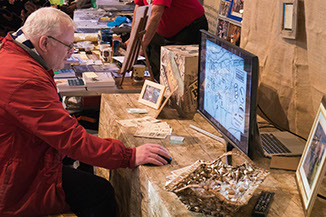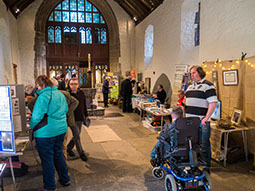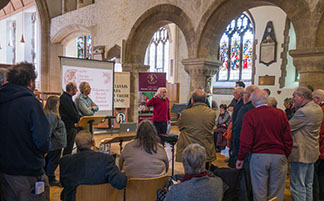
Chartism Convention November 2017
Key Speaker: Rhian E. Jones

The Keynote Speaker: RHIAN E. JONES (author of Petticoat Heroes, UWP 2015) gave an excellently illustrated lecture on Rebecca, a phenomenon that figured across the communities of West Wales between 1839 and 1844. The followers of Rebecca should not be seen merely as vandals smashing toll-gates. ‘She’- Rebecca - appeared against a background of economic depression, high rents, tithes, poor rates, work houses and the increasing privatisation of the common land. Her duty was to correct wrongs and impose justice. In demolishing tollgates, they targeted a popular symbol of injustice. The trigger for this action was the imposition of tollgates and the increase of tolls on newly privatised roads and additional tollgates erected on existing turnpikes. The destruction of the tollgates was carried out by tenant farmers, who were faced with these added costs of getting their produce to market. Like Luddism, the Swing Riots, the Scotch Cattle and Chartism, Rebecca was a response to the social and economic injustices of a market economy and industrial capitalism. The cross-dressing had connections with the customs of the Mari Lwyd and Ceffel Pren, ancient traditions of ‘misrule’. They sought anonymity and empowerment by dressing up in women’s clothes, sometimes wearing wigs.
The Commission of Inquiry established October 1843, reported March 1844 and placed blame for the riots upon the subversive influences of the Welsh language and Welsh nonconformity, but it did also provide practical solutions to the major set of grievances. The three commissioners recommended lowering and equalisation of charges, reduction in the number of toll gates and the setting up of county road boards to regulate the turnpikes. Amazingly, these reforms were passed within a further five months as an Act of Parliament (August 1844).
Rebecca left a legacy and a tradition that later protest movements in Wales have copied and emulated. Rebeccaism may have dropped out from official attention following government intervention in 1844, but it did not die. A second Rebecca Riots occurred in 1870s & 80s Radnorshire over the privatisation of salmon reserves, Rebecca’s name and image, Rhian says “have been continuously referenced in twentieth and twenty-first century Welsh protest.” She cited a string of examples including the radical magazine established by Paddy French, titled Rebecca (1973); the 1970s Welsh arts collective known as the BECA group, in protest at the lack of official recognition or support in Wales for politicised art; environmental protesters in Pembrokeshire at the turn of the millennium took the name Deffro Rebecca (‘Wake up Rebecca’) and wore ‘traditional’ Welsh dress. She pointed out that “Rebeccaite symbolism is fluid and flexible, capable of inspiring popular action far removed from the purposes of its originators” - in modern parlance, it’s ‘a unit for carrying cultural [or political] ideas’ – a meme. Rhian concluded with the observation that “Many of us are still Rebecca’s children.”

Cllr. Charles Ferris


Ray Stroud






Jeremy Knight
Photos: Gareth Croft









